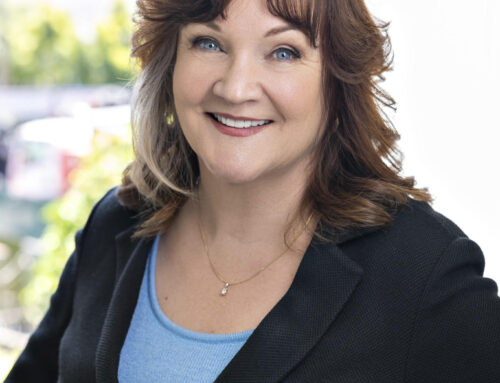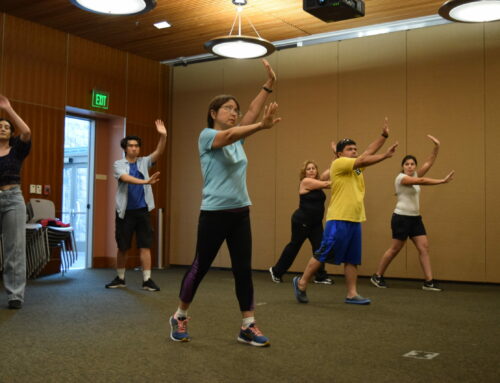Health officials are concerned about potential risk of a fourth surge of COVID-19 cases in next few weeks

Photo by Marty Cheek
Lupe Barajas, a teacher at a charter school in Hollister, receives a shot from Safeway pharmaceutical technician Magdalena Temes at Sobrato High School March 10.
By Staff Report
One year after the pandemic forced most Americans to shelter in place, Santa Clara County is expected to drop from the red tier into the orange tier by Wednesday, March 24.
COVID-19 cases have been in decline, according to Public Health Officer Dr. Sara Cody, thus allowing the county in the orange tier to ease restrictions for businesses to operate and individuals to gather.
“Santa Clara County is great at getting vaccines out. The key to how fast we move through the state’s tier system (red to orange to yellow) and return to normalcy is directly related to how quickly the state and federal governments give us vaccines,” said Supervisor Mike Wasserman who represents the South Valley region. “Give us 125,00 vaccines a week and we’ll have herd immunity before the first day of summer.”
Santa Clara County went from the purple tier (“high risk” level) to red tier (“substantial risk” level) on March 2. As of March 19 the county has seen 113,173 cases of COVID-19 and 1,892 deaths. Morgan Hill has had 3,456 cases and 50 deaths. Gilroy has had 7,388 cases and 90 deaths.
San Mateo County became the first Bay Area county March 16 to return to the orange (“moderate” risk) restriction tier. The next tier is the yellow (“minimal risk”) level. Gov. Gavin Newsom announced a green tier is in development.
 Under the orange tier, restaurants can open up to indoor dining a maximum 50 percent capacity or 200 people, whichever is fewer. Churches and other religious facilities can open up to 50 percent capacity indoors. Gyms and other fitness centers can open indoors with up to 25 percent user capacity.
Under the orange tier, restaurants can open up to indoor dining a maximum 50 percent capacity or 200 people, whichever is fewer. Churches and other religious facilities can open up to 50 percent capacity indoors. Gyms and other fitness centers can open indoors with up to 25 percent user capacity.
Distribution of the vaccine has been a barrier to widespread inoculation of county residents. Allocations of COVID-19 vaccine have been insufficient to resume widespread scheduling of first doses. However, targeted outreach to the county’s most disproportionately affected communities continues. These efforts include multiple vaccination clinics for workers at agriculture facilities in Gilroy and Morgan Hill earlier this month. The county vaccinated food and agricultural workers on-site at Lusamerica Foods and Kawahara Nursery, and facilitated a special vaccination clinic in partnership with Olam Spices and the UFW Foundation in Gilroy that was open to workers from other farms.
“The lack of sufficient supply from the state has been frustrating for everyone, particularly those who are eligible for the vaccine, and want to be vaccinated, but have been unable to sign up,” said Dr. Marty Fenstersheib, testing and vaccine officer for the county, in a press release. “We have had to use almost all of the vaccine we receive for second doses, and have continued to provide access for our hardest hit communities to the greatest extent possible given ongoing shortages.”
This week will see the opening of drive-through vaccination capacity at Gilroy High School, in addition to the walk-in clinic currently operating on the campus.
The county expects vaccine supply may increase significantly statewide in a few weeks, including through additional supplies of the one-dose Johnson & Johnson vaccine.
The cumulative number of COVID-19 tests performed in the county is more than three million as of mid-March. This milestone shows how far testing capacity has come since a year ago, when the World Health Organization declared that the rapidly spreading new virus was now a pandemic. What started with several hundred tests a day at the time has now grown to a testing operation that, during the peak winter surge, collected more than 25,000 specimens daily.
In the early months of the pandemic, one of the county’s first priorities was to quickly scale up testing, a critical component to understanding where and to what level the virus was spreading, Fenstersheib said.
“Testing is one of our most important public health tools when it comes to COVID-19. Without it, we are essentially blind to where the virus is and how quickly it is spreading through our community,” he said. “We now know so much more about disease transmission and prevention than we did a year ago. But one thing has not changed, and that is the critical role of testing.”
Testing remains free, easy and confidential. Frontline workers should get tested at least once a month and up to once every two weeks, and continue testing even after being vaccinated, the county recommends.
Health officials are concerned about the potential risk of a fourth surge of COVID-19 cases in the next several weeks in the U.S. This might happen as some American states significantly lower public health restrictions such as masking and social distancing. The spread might also occur after spring-break travels. The rise of more contagious variants of COVID-19 can also contribute to the potential surge.
At least two cases of the SARS-CoV-2 variant B.1.351, also known as the South African variant, have been detected in the county. One individual was tested in early March and the specimen was randomly selected for genomic sequencing. This is the fourth confirmed case of the B.1.351 variant in the State of California. The second case is believed to have resulted from community transmission and is not travel related. A travel-related case of the South African variant was detected in Santa Clara County earlier this year.
“Considering the national trends, we have been operating under the assumption that these variants were circulating at some level in our communities,” Cody said in a press release. “This latest case confirms that we do have community transmission, and reminds us to not let down our guard in the middle of this pandemic.”
The development of the South African variant incidents comes as the number of cases linked to another variant of concern, B.1.1.7 — which was first identified in the United Kingdom — has increased to 15 in Santa Clara County. Health officials caution that the true level of community spread tied to these variants is unknown. Current genomic sequencing capabilities only allow a fraction of positive cases to be sequenced.
“There is still a lot we are learning, but we do know some very key things about COVID-19 and how to protect ourselves,” said Dr. George Han, deputy health officer for the county, in a press release.
With these variants circulating, he recommends continuing to wear masks, keep a six-foot distance from others, avoid gatherings especially those indoors, and get vaccinated when an opportunity is available.







